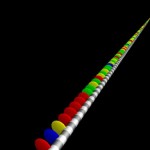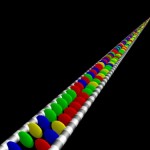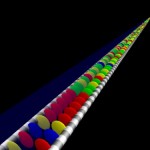When Watson and Crick described the structure of DNA many years ago, the concept of the double helix was new and exiting. Nowadays this concept is dominating visual presentations of DNA to such a degree that it dominates other, more important features of the molecule(s). These features are the topic of the following post:
First of all let us have a look at a single DNA molecule:
It is a bit schematic, I admit, but it emphasizes the essential features: There is a chemical backbone, which is formed by the continuous repetition of two different elements (white and grey colour) and there are side groups attached to this backbone at equal distances. This is a scheme often used for biological macromolecules and humans have adopted it when constructing macromolecules of their own. In the case of DNA, there are only four different side groups (four different colours in this picture). In a world where everything is encoded in 0 and 1, it is funny to note that scientists back in the 30s and 40s thought 4 different letters not to be sufficient to encode biological information and preferred proteins with 20 different side groups.
Apart from this very basic construction scheme (which allows a quick assembly with simple building blocks and tools), another important feature of DNA-molecules can be seen: DNA-molecules usually are very long. (Here only 8500 building blocks are shown. Most molecules contain many more.)
The second important thing about DNA is the fact that these molecules usually come in pairs,
with the sequences in the two strands reflecting each other. ‘Reflecting’ means that both sequences are complementary to each other (side groups with complementary colours) not identical. This is an ingenious concept, which allows to repair eventual damages to one of the two strands and to easily copy the whole information.
These are the main features of DNA molecules. The molecules look more interesting when shown in their helical conformation, but I find this somewhat distracting. (In general, I have the impression there are too many helices on the internet… But, inevitably, there will be some helices, when it comes to packaging all this information).
The pictures shown here are not state of the art, of course. Just quick and dirty visualization… For compensation (sort of), here comes a picture how it would look like, if DNA really was mirrored (which is not the case!). (It shows a single strand molecule reflected in a bluish mirror.)



